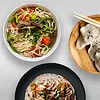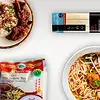What is Vietnamese Coffee?
What is Vietnamese coffee? Simply put, it is coffee grown and produced in Vietnam. While many associate Vietnamese coffee with the phin filter, sweetened condensed milk, and a robust flavor, these are merely elements of its unique profile. We aim to broaden the understanding of Vietnamese coffee beyond these traits! Read this blog and watch our videos as part of our Ultimate Guide to Vietnamese Coffee!
Brought to Vietnam by the French in the mid-19th century, coffee has not only survived the tides of history but has also become a cornerstone of Vietnamese culinary heritage. Today, 'going for coffee' means more than just sipping a cup; it's about catching up with friends, making new connections, or even getting some work done.
History of Vietnamese Coffee
Arabica coffee was introduced in Vietnam by French colonists in the 1850s and was primarily grown in the northern region of the country. This was followed by robusta and excelsa coffee in the first decades of the 20th century, mainly in the central highlands of South Vietnam.
Instead of adding fresh milk, which was scarce at the time – due to an emerging dairy industry, a warm climate, and no refrigeration – French colonists offset the strong taste of robusta coffee with shelf-stable, sweetened condensed milk, resulting in the delicious hot or iced cà phê now available on every street corner in Vietnam.
In the 1920s, more delicate Arabica varieties were planted, especially on the rich basalt soils of the temperate Central Highlands. This volcanic area is also perfect for growing other aromatic crops like cocoa and pepper.
Almost a hundred years later, the Vietnamese coffee industry is flourishing, spurred by economic and political reforms in the 1990s. From that point on, production steadily increased by about 25% per year, with robusta easily outperforming the less resistant varieties by more than 90%.
Since then, Vietnamese coffee has solidified its position in specialty coffee markets. Premium Arabica beans can be roasted longer without burning, while the natural sweetness of robusta beans is enhanced by sun drying, enriching their chocolate undertones and lingering aftertaste. Robusta beans harvested from the Đà Lạt Highlands are even the secret ingredient in many Italian espressos!
Fun fact: Vietnam is actually the second-largest coffee producer in the world, right after Brazil. While most of this production consists of the darker Robusta bean, there is a growing number of farmers who also cultivate Arabica, a lighter bean that is more popular in the West.
What is the difference between Arabica and Robusta beans?
Robusta beans contain 60% less sugar and fats than Arabica beans, giving them a stronger and more 'robust' flavor. Flavor notes can be chocolatey or nutty. Robusta accounts for about 25% of the world's coffee production.
On the other hand, Arabica beans are lighter, sweeter, and fruitier – they also contain less caffeine. When grown at higher altitudes, Arabica plants become slightly shorter and the beans are more oval-shaped. Arabica accounts for 75% of the world's coffee production.

What are some misconceptions about Vietnamese coffee?
Vietnam produces a lot of cheaply produced Robusta, intended for applications like instant or powdered coffee, leading many to mistakenly assume that all coffee in Vietnam is of low quality.
However, this couldn't be further from the truth: Vietnam not only has thriving arabica productions, but many farmers are also experimenting with high-quality, premium robusta. And don't forget the role that freshness and roasting play in determining the quality of the final product.

How is Vietnamese coffee brewed?
In Vietnam, coffee is usually brewed in a phin filter, which resembles a cross between a V60 pour-over and a French press. These ergonomic brewing tools are highly efficient at making a concentrated cup of coffee.
The phin filter consists of a filter plate, filter chamber, gravity press (or screw press), and a lid. Ground coffee is placed in the chamber, followed by the press. Then, hot water is poured over it to brew the coffee. The water allows the coffee to steep and flows through the filter chamber and filter plate, resulting in a concentrated brew that many compare to espresso.
Nowadays, Vietnamese coffee is prepared in various ways, from pour-over to espresso and more. An important distinction: the phin filter is a traditional brewing method that is an integral part of Vietnamese coffee culture, but it is not synonymous with Vietnamese coffee in general. Vietnamese coffee can be brewed however you like, as long as the coffee beans' grind size is properly set!
The most common way Vietnamese coffee is found is ca phe sua: a coffee drink made with sweetened condensed milk. Served hot or cold, the drink is super popular in Vietnam, where the iced version offers real relief on hot days. (Use this handy recipe to try this drink at home.)
While we love ca phe sua, Vietnamese coffee can refer to so much more than just one drink. Nowadays, some of the fun variations you can find in Vietnamese coffee shops include coconut coffee and even egg coffee, which became popular in the Vietnamese capital Hanoi.

How to Make Vietnamese Coffee
To make Vietnamese coffee, you will need:
- Fresh Vietnamese coffee (something grown and produced in Vietnam)
- Hot water around 93ºC (200ºF)
- A brewing tool of your choice
There is no precise or absolute way to make or enjoy Vietnamese coffee! While we appreciate and encourage the use of a phin filter, it’s not a must. You can brew your Vietnamese coffee beans in an auto-drip, as cold brew, as espresso, or however you like. Note: you need to grind the coffee appropriately for the specific brewing method.
If you are looking for a recipe to make Vietnamese ICED coffee (cà phê sữa đá), we have you covered. Vietnamese iced coffee is ultimately just a beverage preparation and recipe, although we understand the confusion with Vietnamese coffee in general due to its immense popularity.
What is the best Vietnamese coffee brand?
When Vietnamese refugees flooded into the U.S. in the 1970s, they were eager to find a substitute for their favorite drink: cà phê sữa đá. Since then, many imported types of Vietnamese coffee or Vietnamese-style coffee have increased in the U.S. Many Vietnamese Americans also associate coffee with Cafe Du Monde, which is actually a French coffee company that roasts chicory. Although it is not truly Vietnamese or Vietnamese-style coffee, this brand has a strong presence among the Vietnamese diaspora. We are not including it in this list because we are exclusively discussing coffee types that originate from Vietnam. Today, the offerings are becoming more widely available as the world wakes up to Vietnamese coffee.
Trung Nguyen
Trung Nguyen offers a variety of coffee products in Vietnam and abroad. One of them, their G7 coffee, is a classic. Just pure black coffee, each G7 Instant sachet fills an 8 oz cup, with only 20% less caffeine (60 mg) than an average serving of freshly brewed coffee. This Trung Nguyen product is an instant mood booster, with about 0.2 g of natural sugar content in these beans. Organic and guaranteed fresh, convenient G7 3-in-1 Instant sachets contain only coffee, milk, and sugar. For fans of traditional Vietnamese cà phê sữa đá, they are a budget-friendly energy kick that is easy to make anytime, anywhere.




 New Arrivals
New Arrivals
 Outlet
Outlet
 Search by country
Search by country
 Search per category
Search per category
 Holiday Season
Holiday Season
 Recipes
Recipes
 Tjin's Blog
Tjin's Blog









